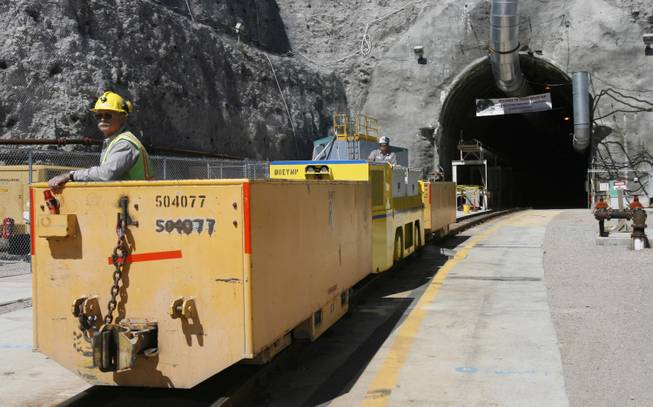
Isaac Brekken / AP
In this April 13, 2006, file photo, an underground train at the entrance of Yucca Mountain in Nevada.
Sunday, May 26, 2019 | 2 a.m.
View more of the Sun's opinion section
Proponents of the Yucca Mountain nuclear waste repository like to say that the science behind the project is sound and that the site is safe. In doing so, they might cite the conclusion of a body of work known as the Total System Performance Assessment.
I was reminded of the TSPA recently when a young woman who is producing a documentary about Yucca Mountain contacted me to ask where she could see a copy of it.
My working colleague who is focused on the scientific side of nuclear waste disposal laughed about her request, because the TSPA is so complicated and huge that it is very difficult to download to your computer screen and there aren’t many paper copies around because it takes up so much space.
It’s also a deeply flawed piece of work.
Produced by the Department of Energy, the TSPA is the computer software compilation and analysis of the tens of thousands of pages of scientific data about Yucca Mountain integrated with the engineering design of the repository. The conclusion is the expected annual radiation dose to an individual in the public from the calculated releases from the repository through a long period of time.
Proponents say that Yucca Mountain is safe because the TSPA calculated dose does not exceed the dose limit for releases from the repository set by the Environmental Protection Agency.
There are two big problems with relying on the TSPA for a safety claim. The first is that its accuracy cannot be demonstrated, and the second is that it is so complex that it is inaccessible to all but the people who built it for the department.
When researchers were gathering data on the site during the 1980s and ’90s, they fed it into what we now know were pretty primitive computer models. But there were gaps in the data, which prompted the managers to seek expert judgment to fill those holes. The results of the individual models would then be fed into the next series of models. It was obvious that any necessary or important data collection that had been overlooked or done wrong anywhere in the process would then feed into the next set a questionable data and mistakes would be carried along.
During that time, I remember one of the Energy Department managers talking about how they were trying to “drive the doses down.” One of the grassroots people I work with called that “pencil whipping Yucca Mountain into compliance.” The TSPA had taken the phrase “garbage in/garbage out” to a wildly new level.
Finally, the cast of thousands working on the project decided they had enough information plugged into the myriad models, and they devised a system that would run the TSPA. The plan was to perform this overwhelming run by connecting the desktop computers of 60 employees because there was so much data that no one computer could handle it. When the results finally spit out at the end, everyone was told that this was the convincing evidence that no one in Nevada had any reason to worry about Yucca Mountain and the thousands of tons of waste it would hold.
For those of us with a little scientific knowledge but enough common sense to live our everyday lives, this thing was at first ridiculous and funny but became horrifying. We realized that they actually believed the results and were turning them into a license application in order to get approvals to build the repository.
So once again, we are talking about the science behind Yucca Mountain. And once again, Nevada’s fate lies in the hands of people making dubious claims to understand the scientific integrity of the Energy Department’s safety conclusions.
The evidence of the safety of a Yucca Mountain repository — the TSPA — comes across as a fantastical Rube Goldberg machine, only really appreciated by the scientists and engineers who can intellectually get into it. So the way to sway government decision makers and skeptical regular people is to just take a field trip and look.
People are deciding on a site that is safe enough for failure.
Those not familiar with or appreciative of the fragile desert environment can stand atop Yucca Mountain, hundreds or thousands of miles from where they live, and feel there’s nothing to harm even though they know nothing about the studies, research or modeling.
What they don’t see is the groundwater beneath the mountain that is part of a vast, ancient and pristine aquifer under the surrounding desert floor, providing water to the nearby farming area with a huge dairy and the communities further west.
After more than three decades of study that revealed the flaws in Yucca Mountain and all of the proposed engineering fixes to get around or overcome them, it is clear that hope and lots of money will not assure safety. So the only other choice is to promote Yucca Mountain as a site where failure is acceptable and safe enough.
Judy Treichel is executive director of the Nevada Nuclear Waste Task Force.
